Hairwork Jewelry
“Drawing from his bosom a locket, which was attached to a slight steel chain, he opened it and showed me a tress of golden hair. “In this curl is clasped the history of my life, friend,’ he said, with calm sorrow. “’Tis only a woman’s hair,’ as poor Swift wrote once; yet it is this which has made me what I am. God rules us all. He makes us very weak, that, in our weakness, He may make His own strength perfect. To one comes joy and laughter; to another tears. I accept my part, and bow to Him who is Lord of all” – Anonymous, 1859
Jewelry incorporating human hair have been in existence since at least the 1500s. They probably share a cultural lineage with Christian relics, which housed various body parts of saints or martyrs and were believed to possess spiritual power. Early hairwork jewelry from the sixteenth and seventeenth centuries were frequently love tokens or mourning jewelry incorporating the hair of a loved one rather than a saint, and they often included momento mori symbolism. Hairwork jewelry became popular in Europe and America after 1760 and extremely popular after the industrial revolution provided the middle classes with less expensive, mass produced jewelry findings. It is a common mistake to assume that all hairwork jewelry were mourning objects. In this latter period, hairwork jewelry provided a sentimental memorial to love, friendship, family, celebrity, and, of course, mourning.
PALETTE WORKED HAIR
Hairwork jewelry designed and executed on an artist’s palette is referred to as “palette worked.” The designs produced by palette work range from simple basket weaves to extremely intricate and symbolic or allegorical scenes (see the hairwork piece in the mourning jewelry post, for example).
This pendent brooch contains a palette worked forget-me-not and curl on translucent milk glass backed by embossed red foil. Scale in centimeters.
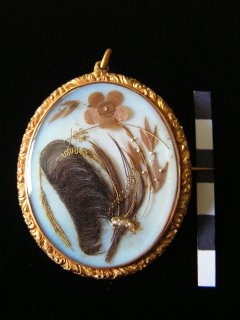
On the reverse, there are two hairwork curls each labeled with initials, “E.O.” and “H.C.O.,” spelled out in tiny seed pearls on translucent blue enamel plaques backed with embossed foil.

This brooch contains a beautiful palette worked feather sculpted from red hair with flower, branch, and the initials “B.P.” on opalescent glass.
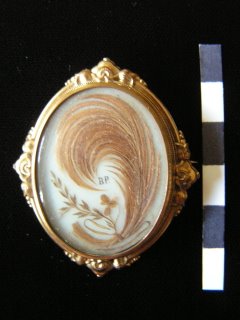
TABLE WORKED HAIR
The revival of hairwork jewelry in the 1980-90s has revealed that the equipment and basic patterns for table work hair braiding are identical to kumihimo braiding in Japan. Kumihimo braiding was used to construct durable silk cords for clothing and samurai armor from at least 700 AD to the present. However, this method of working hair was probably independently invented in Europe and shares no lineage with Japanese kumihimo. It nevertheless uses the same technique of weighted hair strands joined by a counter weight and passed back and forth across different quadrants of the tabletop.
This brooch and earrings set was constructed with the table work method using a pattern for a hollow open work braid.

This watch chain was constructed from two different patterns for solid chains, which were then braided together. The hairwork beads encased in gold wire were crafted using a hollow open work pattern.

The hairwork beads suspend a double-sided locket with two different palette worked hair designs on each side.
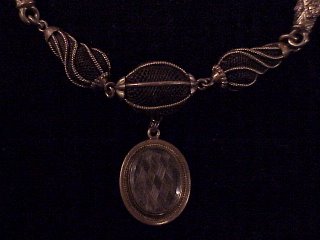
This engraving of the same watch chain pictured above comes from the catalog pages of Mark Campbell’s 1875 how-to book for the amateur hairworker.

HAIRWORK BOXES
Hairwork was not limited to jewelry. In the nineteenth century, human hair was added to just about every object suited to receive it, and small boxes were no exception. This ivory box houses a palette worked basket weave design on the lid.
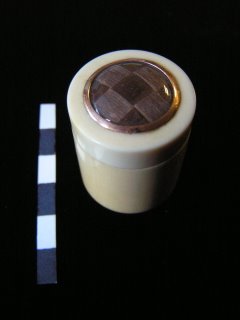
This tortoise shell box has exquisite engine-turned engraving over every part of the outer surface…

And houses hairwork on the underside of the lid with a gold heart and the initials, “H.F.,” “J.F.,” “E.F.,” and “F.F.,” indicating that the hair probably came from members of a single family.


HAIRWORK PLAQUES
Larger, upwards of fifteen centimeters, hairwork plaques were also produced in the nineteenth century as cabinet pieces. The plaque below houses three different colors of hair arranged into a spray of curls, feathers, and a pansy symbolic of “think-of-me” in the language of flowers.
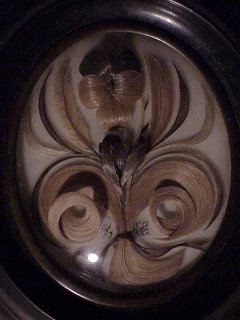
Jewelry incorporating human hair have been in existence since at least the 1500s. They probably share a cultural lineage with Christian relics, which housed various body parts of saints or martyrs and were believed to possess spiritual power. Early hairwork jewelry from the sixteenth and seventeenth centuries were frequently love tokens or mourning jewelry incorporating the hair of a loved one rather than a saint, and they often included momento mori symbolism. Hairwork jewelry became popular in Europe and America after 1760 and extremely popular after the industrial revolution provided the middle classes with less expensive, mass produced jewelry findings. It is a common mistake to assume that all hairwork jewelry were mourning objects. In this latter period, hairwork jewelry provided a sentimental memorial to love, friendship, family, celebrity, and, of course, mourning.
PALETTE WORKED HAIR
Hairwork jewelry designed and executed on an artist’s palette is referred to as “palette worked.” The designs produced by palette work range from simple basket weaves to extremely intricate and symbolic or allegorical scenes (see the hairwork piece in the mourning jewelry post, for example).
This pendent brooch contains a palette worked forget-me-not and curl on translucent milk glass backed by embossed red foil. Scale in centimeters.

On the reverse, there are two hairwork curls each labeled with initials, “E.O.” and “H.C.O.,” spelled out in tiny seed pearls on translucent blue enamel plaques backed with embossed foil.

This brooch contains a beautiful palette worked feather sculpted from red hair with flower, branch, and the initials “B.P.” on opalescent glass.

TABLE WORKED HAIR
The revival of hairwork jewelry in the 1980-90s has revealed that the equipment and basic patterns for table work hair braiding are identical to kumihimo braiding in Japan. Kumihimo braiding was used to construct durable silk cords for clothing and samurai armor from at least 700 AD to the present. However, this method of working hair was probably independently invented in Europe and shares no lineage with Japanese kumihimo. It nevertheless uses the same technique of weighted hair strands joined by a counter weight and passed back and forth across different quadrants of the tabletop.
This brooch and earrings set was constructed with the table work method using a pattern for a hollow open work braid.

This watch chain was constructed from two different patterns for solid chains, which were then braided together. The hairwork beads encased in gold wire were crafted using a hollow open work pattern.

The hairwork beads suspend a double-sided locket with two different palette worked hair designs on each side.

This engraving of the same watch chain pictured above comes from the catalog pages of Mark Campbell’s 1875 how-to book for the amateur hairworker.

HAIRWORK BOXES
Hairwork was not limited to jewelry. In the nineteenth century, human hair was added to just about every object suited to receive it, and small boxes were no exception. This ivory box houses a palette worked basket weave design on the lid.

This tortoise shell box has exquisite engine-turned engraving over every part of the outer surface…

And houses hairwork on the underside of the lid with a gold heart and the initials, “H.F.,” “J.F.,” “E.F.,” and “F.F.,” indicating that the hair probably came from members of a single family.


HAIRWORK PLAQUES
Larger, upwards of fifteen centimeters, hairwork plaques were also produced in the nineteenth century as cabinet pieces. The plaque below houses three different colors of hair arranged into a spray of curls, feathers, and a pansy symbolic of “think-of-me” in the language of flowers.




0 Comments:
Post a Comment
<< Home